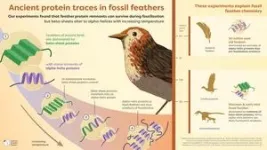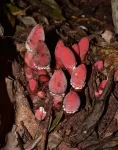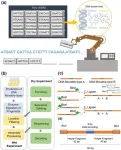(Press-News.org) The team, led by Imperial College London researchers, uncovered the wiring in mouse brains that leads them to begin nesting in preparation for sleep. Published today in Nature Neuroscience, the study reveals that preparing properly for sleep is likely a hard-wired survival feature – one often neglected or overridden by humans.
We all need to sleep, but since we are unconscious when we do so, it makes sense to fall asleep in a safe and warm place. For some animals this is especially important, as a burrow or nest provides a haven from predators.
Dr Kyoko Tossell, from the Department of Life Sciences at Imperial, and colleagues in the Franks-Wisden lab found that depriving mice of sleep produces an instinctive behaviour to build a nest, or in other words, get ready for bed. They also revealed the brain wiring responsible for this behaviour, which is likely to be shared across mammals.
Dr Tossell said: “Although it seems to us humans that we have a conscious control of the process of going to bed, it is very likely that the same wiring exists in the human brain as the mouse brain. So, even if we think we are making a choice, we are probably governed by unconscious urges to prepare for bed as mice are.”
Professor Bill Wisden, Chair in Molecular Neuroscience at Imperial, added: “Getting a good night’s sleep is vital for health. And preparing for bed properly – what clinicians refer to as ‘sleep hygiene’ (such going to bed at a suitable time, on a proper mattress, with good sheets and no phone or TV) – is equally important, but is often neglected or overridden by many. The fact that this process is hard-wired in mice shows that preparing properly for sleep is a survival feature used in nature, and so humans should take this aspect of their sleep seriously.”
To delve deeper into the sleep preparations of mice, the team deprived the mice of sleep and then observed their behaviour and brain activity when they were eventually allowed to drop off. They made mice sleepy by presenting them with Lego bricks and other toys every half an hour for five hours, which caused them to stay awake instead of napping, and filmed their nesting behaviour before they finally went to sleep.
To look at the brain wiring involved in nesting, the authors used a method called optogenetics, where particular brain cells can be artificially activated by a flash of light. This allowed them to experimentally verify that dedicated brain cells were responsible for nesting when the mice were sleepy.
They discovered that sleep preparatory behaviour is wired up in the top of the brain, in a region called the prefrontal cortex. In humans and mice, the prefrontal cortex helps in rational planning, or ‘executive control’, which is often essential for survival.
As mice become progressively more tired, the team discovered that special types of neurons become active in the prefrontal cortex and send signals down to the base of the brain, the hypothalamus. The hypothalamus is the brain’s control centre for regulating many of the basic survival processes needed by the body, including eating, drinking, and sleeping.
Down in the hypothalamus, special memories (or instincts) are stored for nest building and the wiring to trigger sleep.
Dr Tossell said: “In other words, when tiredness starts to wash over the mouse, the top part of the brain (the prefrontal cortex) decides to implement behaviour to make sure the mouse is in a safe place before going to sleep.”
Now this brain wiring has been discovered, the team want to expand their studies to uncover what makes the prefrontal cortex cells active during tiredness and how the brain actually senses tiredness. Professor Nick Franks said: “As the next steps for our work, we would like to discover the answers to these questions as they may provide an answer to one of the biggest questions in neuroscience: why do we sleep?”
END
Getting ready for bed controlled by specific brain wiring in mice
2023-09-21
ELSE PRESS RELEASES FROM THIS DATE:
Mutation-specific peptide vaccine against midline gliomas used in patients for the first time
2023-09-21
Tumor vaccines can help the body fight cancer. These vaccines alert the patient's immune system to proteins that are carrying cancer-typical alterations. Physicians and cancer researchers from Heidelberg and Mannheim have now treated adult patients with advanced midline gliomas, difficult-to-treat brain tumors, with a peptide vaccine for the first time. The vaccine mimicked a mutational change in a histone protein typical of this type of cancer. The vaccine proved to be safe and induced the desired immune responses directed ...
This parasitic plant convinces hosts to grow into its own flesh—it’s also an extreme example of genome shrinkage
2023-09-21
If you happen to come across plants of the Balanophoraceae family in a corner of a forest, you might easily mistake them for fungi growing around tree roots. Their mushroom-like structures are actually inflorescences, composed of minute flowers.
But unlike some other parasitic plants that extend an haustorium into host tissue to steal nutrients, Balanophora induces the vascular system of their host plant to grow into a tuber, forming a unique underground organ with mixed host-parasite tissue. This ...
Mutations in 11 genes associated with aggressive prostate cancer identified in new research
2023-09-21
An international research team led by scientists in the Center for Genetic Epidemiology at the Keck School of Medicine of USC and USC Norris Comprehensive Cancer Center has singled out mutations in 11 genes that are associated with aggressive forms of prostate cancer. These findings come from the largest-scale prostate cancer study ever exploring the exome — that is, the key sections of the genetic code that contain the instructions to make proteins. The scientists analyzed samples from about 17,500 prostate cancer ...
Dinosaur feathers reveal traces of ancient proteins
2023-09-21
Palaeontologists at University College Cork (UCC) in Ireland have discovered X-ray evidence of proteins in fossil feathers that sheds new light on feather evolution.
Previous studies suggested that ancient feathers had a different composition to the feathers of birds today. The new research, however, reveals that the protein composition of modern-day feathers was also present in the feathers of dinosaurs and early birds, confirming that the chemistry of feathers originated much earlier than previously thought.
The research, published today in Nature Ecology and Evolution, was led by palaeontologists ...
Researchers develop first method to study microRNA activity in single cells
2023-09-21
MicroRNAs are small molecules that regulate gene activity by binding to and destroying RNAs produced by the genes. More than 60% of all human genes are estimated to be regulated by microRNAs, therefore it is not surprising that these small molecules are involved in many biological processes including diseases such as cancer. To discover the function of a microRNA, it is necessary to find out exactly which RNAs are targeted by it. While such methods exist, they require a lot of material typically in order of millions of cells, to ...
Nanoparticles made from plant viruses could be farmers’ new ally in pest control
2023-09-21
A new form of agricultural pest control could one day take root—one that treats crop infestations deep under the ground in a targeted manner with less pesticide.
Engineers at the University of California San Diego have developed nanoparticles, fashioned from plant viruses, that can deliver pesticide molecules to soil depths that were previously unreachable. This advance could potentially help farmers effectively combat parasitic nematodes that plague the root zones of crops, all while minimizing costs, pesticide use and environmental toxicity.
Controlling infestations caused by root-damaging nematodes has long been a challenge in agriculture. One reason is that the types of pesticides ...
Social vs. language role: researchers question function of two brain areas
2023-09-21
A research team led by Prof. LIN Nan from the Institute of Psychology of the Chinese Academy of Sciences found that during sentence processing, the neural activity of two canonical language areas, i.e., the left ventral temporoparietal junction (vTPJ) and the lateral anterior temporal lobe (lATL), is associated with social-semantic working memory rather than language processing per se.
The study was published in Nature Human Behaviour on Sept. 21.
Language and social cognition are two deeply interrelated abilities of the human species, but have traditionally been studied ...
Inauguration ceremony of carbon future
2023-09-21
On September 17th, 2023, Carbon Future, an international interdisciplinary journal sponsored by Tsinghua University, has been officially inaugurated.
Carbon Future is an open access, peer-reviewed and international interdisciplinary journal that reports carbon-related materials and processes, including carbon materials, catalysis, energy conversion and storage, as well as low carbon emission process and engineering. The journal is published quarterly by Tsinghua University Press, and publicly released on SciOpen, an internationally digital ...
Revolutionizing data storage: DNA movable-type system paves the way for sustainable data storage technology
2023-09-21
In a groundbreaking study published in Engineering, researchers have developed a revolutionary method for data storage using DNA. The paper titled “Engineering DNA Materials for Sustainable Data Storage Using a DNA Movable-Type System” introduces a novel approach that utilizes DNA fragments, referred to as “DNA movable types,” for data writing, thereby eliminating the need for costly and environmentally hazardous DNA synthesis.
DNA molecules have long been recognized as green materials ...
NIH center grant bolsters male contraceptive research
2023-09-21
Weill Cornell Medicine has received a three-year, nearly $6 million grant to lead one of three national contraceptive research centers. The grant from the Eunice Kennedy Shriver National Institute of Child Health and Human Development, part of the National Institutes of Health, will fund the Weill Cornell Medicine Contraception Development Research Center. Led by Drs. Jochen Buck and Lonny Levin, both professors of pharmacology at Weill Cornell Medicine, the center will focus on developing an on-demand male contraceptive.
“It’s an honor to be selected for a second time for this award,” Dr. Levin ...






